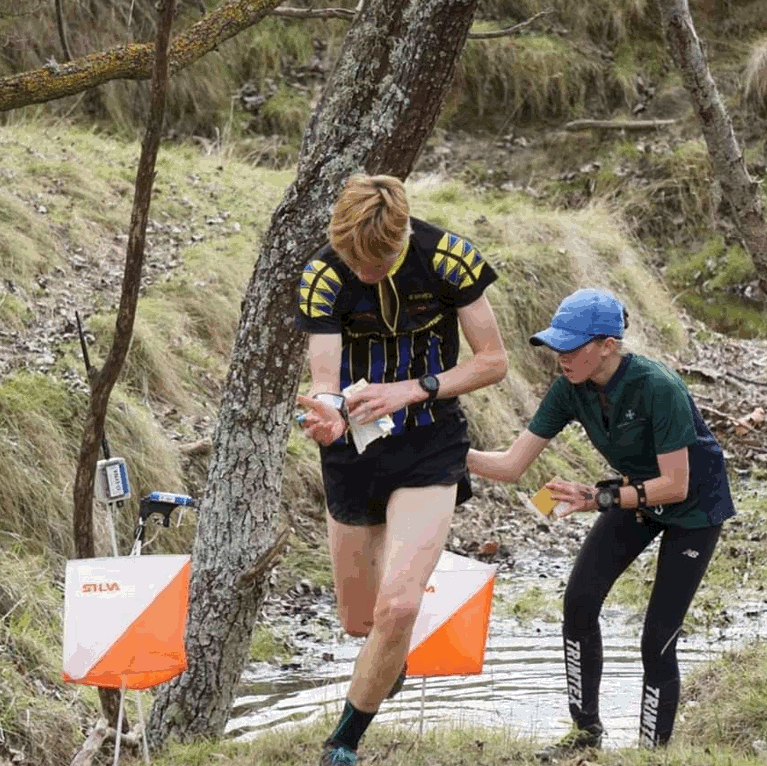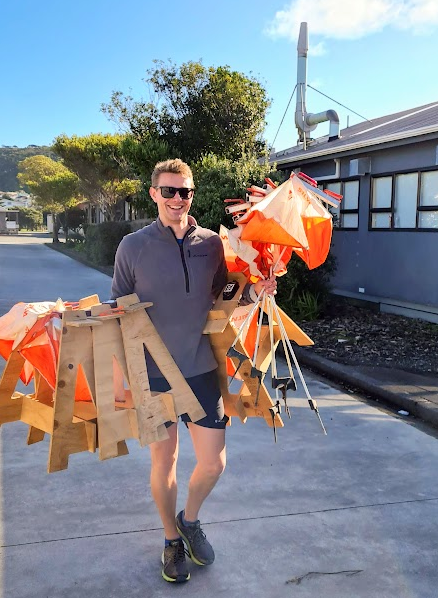Event planning
Wellington Event Planning - What to do
These guidelines will give you an idea of the process of planning an orienteering event for Orienteering Wellington.
The full rules for planning orienteering events can be found in the NZ Orienteering Competition Rules. This page focuses on detail specific to Wellington (what types of events occur in Wellington, processes and timelines etc.)
What courses and how long should they be?
Course difficulty
The following course definitions are from the Orienteering NZ FAQ:
- White Course: Courses follow drawn linear features (tracks, fences, streams, distinct vegetation boundaries, etc.). Compass use is limited to map orientation only.
- Yellow Course: Control sites on or near (<50 m) drawn linear features (tracks, fences, streams, distinct vegetation boundaries, etc). This gives the opportunity to follow handrails or to cut across country (i.e. limited route choice). Compass use is limited rough directional navigation. Contour recognition is not required for navigation but simple contour features may be used for control sites.
- Orange Course: Courses have route choice with prominent attack points near the control sites and/or catching features less than 100 m behind. Control sites may be fairly small point features and the control markers need not necessarily be visible from the attack point. Simple navigation by contours and rough compass with limited distance estimation required.
- Red Course: Navigation is as difficult as possible with small contour and point features as preferred control sites (no obvious attack points, no handrails etc.). Route choice is an important element in most legs.
Course lengths
A good way to work out an appropriate course length is to search Winsplits and Routegadget for events on that map on previous years. The example below suggests a course at Mill Creek of 4.2km is very slightly short. Obviously differences in climb and vegetation on the course will mean this is only a rough guide.

The winning time will also depend on who runs the course. You should set the course to have the given winning time based on who you would expect to run that course.
As a rough guide, you could expect :
- Red long: experienced M/W21 runners
- Red medium: experienced M/W50
- Red short: experienced M/W60+
- Orange is difficult because it attracts a mix of abilities, but aim for a winning time you would expect for a 13-14 year-old who is confident with navigation using big contours and other large features. This course also tends to attract adventure racers.
- Yellow: A 10 year-old who is confident navigating to large features away from paths or tracks.
- For white, expect young children (5+) with their parents; winning time would be based on a 7-8 year old.
Wellington event types
College Sport Wellington (CSW) weekend events
CSW events tend to have the following courses: Red Long, Red Medium, Red Short, Orange, Yellow, White. In some cases, such as where the map is small, it may make sense to not have a Red Long.
Generally, you want the winning time of orange and red courses to be around 45 minutes (give or take a bit). The yellow and white courses should have a winning time of 20-30 minutes.
CSW requires us to relate a Course (red, yellow etc.) to an age class (e.g. M16). The below is an example of the Classes used in CSW and how they relate to a course:
| Grade | School Year | Championship | Standard | Novice |
|---|---|---|---|---|
| Senior | 12 & 13 | Difficult (Red) | Medium (Orange) | Easy (Yellow) |
| Intermediate | 10 & 11 | Medium (Orange) | Easy (Yellow) | |
| Junior | 9 | Easy (Yellow) | Very Easy (White) |
CSW Sprint
CSW Sprint events generally have a Long course and a Short course.
The Long course should be technically challenging (Red) and aim for a winning time of 15 minutes for M18A.
The short course should be easy to moderately challenging (Yellow/Orange) and aim for a winning time of 15 minutes for M12A.

Orienteer of the Year (OY)
OY courses are generally more technically challenging than a normal club event, and the Red Long winning time may be closer to an hour. Generally, you want the winning time of other orange and red courses to be around 45 minutes (give or take a bit).
The yellow and white courses should have a winning time of 20-30 minutes.
Events tend to have the following courses: Red Long, Red Medium, Red Short, Orange, Yellow, and White.

Afterwork club events
Low key events, such as the Spring Series (which are Wednesday evening events) tend to just have two courses, a long and a short. The long would be around a 30-minute Red, and the Short would be between a Yellow and an Orange.
Weekend club events
Weekend club events should have the following courses: Red Long, Red Medium, Red Short, Orange, Yellow, White. In some cases, such as where the map is small, it may make sense to not have a Red Long. Generally, you want the winning time of orange and red courses to be around 45 minutes (give or take a bit). The yellow and white courses should have a winning time of 20-30 minutes.
Score events
Score events are a little different as each control is assigned a number of points depending on its difficulty and competitors must try to get as many points as possible in the available time. Wellington Score events are generally 60 minutes long.
What do I actually do?
6-3 weeks before the event
- Roughly plan the courses on paper or on your computer;
- Visit the map and check out your control sites, obvious attack points and the quality of the map from attacks point to control sites;
- Check the junior courses in their entirety – the younger and less experienced people are less able to cope with a mismatch between map and ground or dangerous areas;

3-2 weeks before the event
- Send draft courses to the controller;
- Make changes as recommended by the controller;
- Send event details to Event Coordinator (parking, course lengths, climb, no. controls) for ONZ website
- Work with the Controller to complete the HARM (health and safety) form and provide this to the permissions officer along with a draft All Controls map.
- Send the list of courses and classes to Magnus Bengtsson so he can publish the Entries page.
A week before the event
- Ensure your courses are tidied up in Condes (see below) - numbers and control circles clear and not obscuring important features, control descriptions produced on the map correctly;
- Send an ‘all controls’ map to the landowner liaison officer, so they can confirm the landowner has no issues with the control sites.
- You can use the ONZ MapFramer to add fancy borders to your maps. A guide is available on how to use it.
- Send final maps and course XML from Condes to the equipment Officer to be printed by at the latest Wednesday before the (Sunday) event;
- Work with the controller on a plan for making sure controls go in the right place;
- Print out lists of the classes/courses for registration. You can use the Event Information Notice template to help with this.

On the day (or the day before)
Set out controls (agree when with the controller); Be around on the day of the event for the whole event.
After the event
If you have updated the map (.ocd file), send the updated map file to the Mapping Officer
Who will help me?
The controller
Along with your role as the course planner, a controller will be appointed. The controller’s role is to be responsible for the final quality and safety of the courses. They will inevitably have suggestions and requirements which change your courses. Don’t be offended by this – it is surprising how useful it is to have a fresh pair of eyes glance over a set of courses.
The controller is usually very experienced, and usually they see things in a different way to you. Between you and the controller, you are trying to set challenging and enjoyable courses.

Other contacts
See the committee page for contact details.
- The events coordinator can put you in touch with other key people including:
- The landowner liaison person, who will work with you to arrange access to any private land in the event;
- The mapping officer, who will provide the map to plan on, and a form of the map with scale and legend for printing;
- equipment officer for checking available control numbers (typically from 101 upwards) and map printing.
- There will also be somebody organising helpers on the day.
What do I need?
A current version of the course planning software, Condes. Download from http://www.condes.net/index.php/download/
We have a club license for Condes version 10. You need the following to register the copy you download to gain full access:
- Club: Wellington Orienteering Club
- Code: Contact the events coordinator
We can provide guidance on Condes use.
A copy of the map (typically in .ocd format) that will open in Condes; We suggest printing a couple of copies of the map to do your initial sketching of courses.
Time – it takes time to get courses right.